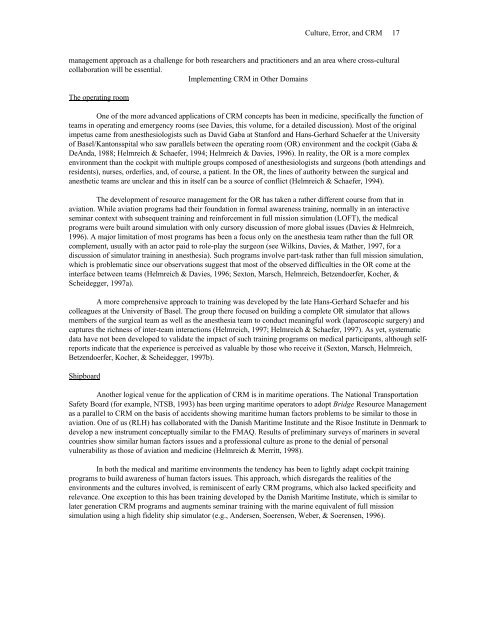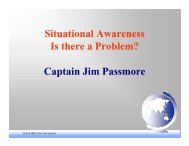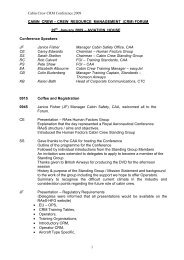Culture, Error, and Crew Resource Management - Human Factors ...
Culture, Error, and Crew Resource Management - Human Factors ...
Culture, Error, and Crew Resource Management - Human Factors ...
You also want an ePaper? Increase the reach of your titles
YUMPU automatically turns print PDFs into web optimized ePapers that Google loves.
<strong>Culture</strong>, <strong>Error</strong>, <strong>and</strong> CRM 17<br />
management approach as a challenge for both researchers <strong>and</strong> practitioners <strong>and</strong> an area where cross-cultural<br />
collaboration will be essential.<br />
Implementing CRM in Other Domains<br />
The operating room<br />
One of the more advanced applications of CRM concepts has been in medicine, specifically the function of<br />
teams in operating <strong>and</strong> emergency rooms (see Davies, this volume, for a detailed discussion). Most of the original<br />
impetus came from anesthesiologists such as David Gaba at Stanford <strong>and</strong> Hans-Gerhard Schaefer at the University<br />
of Basel/Kantonsspital who saw parallels between the operating room (OR) environment <strong>and</strong> the cockpit (Gaba &<br />
DeAnda, 1988; Helmreich & Schaefer, 1994; Helmreich & Davies, 1996). In reality, the OR is a more complex<br />
environment than the cockpit with multiple groups composed of anesthesiologists <strong>and</strong> surgeons (both attendings <strong>and</strong><br />
residents), nurses, orderlies, <strong>and</strong>, of course, a patient. In the OR, the lines of authority between the surgical <strong>and</strong><br />
anesthetic teams are unclear <strong>and</strong> this in itself can be a source of conflict (Helmreich & Schaefer, 1994).<br />
The development of resource management for the OR has taken a rather different course from that in<br />
aviation. While aviation programs had their foundation in formal awareness training, normally in an interactive<br />
seminar context with subsequent training <strong>and</strong> reinforcement in full mission simulation (LOFT), the medical<br />
programs were built around simulation with only cursory discussion of more global issues (Davies & Helmreich,<br />
1996). A major limitation of most programs has been a focus only on the anesthesia team rather than the full OR<br />
complement, usually with an actor paid to role-play the surgeon (see Wilkins, Davies, & Mather, 1997, for a<br />
discussion of simulator training in anesthesia). Such programs involve part-task rather than full mission simulation,<br />
which is problematic since our observations suggest that most of the observed difficulties in the OR come at the<br />
interface between teams (Helmreich & Davies, 1996; Sexton, Marsch, Helmreich, Betzendoerfer, Kocher, &<br />
Scheidegger, 1997a).<br />
A more comprehensive approach to training was developed by the late Hans-Gerhard Schaefer <strong>and</strong> his<br />
colleagues at the University of Basel. The group there focused on building a complete OR simulator that allows<br />
members of the surgical team as well as the anesthesia team to conduct meaningful work (laparoscopic surgery) <strong>and</strong><br />
captures the richness of inter-team interactions (Helmreich, 1997; Helmreich & Schaefer, 1997). As yet, systematic<br />
data have not been developed to validate the impact of such training programs on medical participants, although selfreports<br />
indicate that the experience is perceived as valuable by those who receive it (Sexton, Marsch, Helmreich,<br />
Betzendoerfer, Kocher, & Scheidegger, 1997b).<br />
Shipboard<br />
Another logical venue for the application of CRM is in maritime operations. The National Transportation<br />
Safety Board (for example, NTSB, 1993) has been urging maritime operators to adopt Bridge <strong>Resource</strong> <strong>Management</strong><br />
as a parallel to CRM on the basis of accidents showing maritime human factors problems to be similar to those in<br />
aviation. One of us (RLH) has collaborated with the Danish Maritime Institute <strong>and</strong> the Risoe Institute in Denmark to<br />
develop a new instrument conceptually similar to the FMAQ. Results of preliminary surveys of mariners in several<br />
countries show similar human factors issues <strong>and</strong> a professional culture as prone to the denial of personal<br />
vulnerability as those of aviation <strong>and</strong> medicine (Helmreich & Merritt, 1998).<br />
In both the medical <strong>and</strong> maritime environments the tendency has been to lightly adapt cockpit training<br />
programs to build awareness of human factors issues. This approach, which disregards the realities of the<br />
environments <strong>and</strong> the cultures involved, is reminiscent of early CRM programs, which also lacked specificity <strong>and</strong><br />
relevance. One exception to this has been training developed by the Danish Maritime Institute, which is similar to<br />
later generation CRM programs <strong>and</strong> augments seminar training with the marine equivalent of full mission<br />
simulation using a high fidelity ship simulator (e.g., Andersen, Soerensen, Weber, & Soerensen, 1996).




